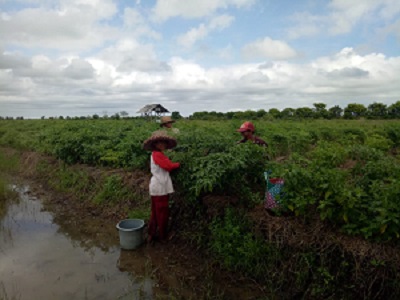
Evaluation of land suitability for the development of Hiyung cayenne pepper in Hiyung Village, Tapin Tengah District, South Kalimantan
Ratna Taher(1*), Muhammad Syarbini(2), Kamiliah Wilda(3)
(1) Faculty of Agriculture, Lambung Mangkurat University Jln. A. Yani Km 35.5, Banjarbaru, Kalimantan Selatan 70714, Indonesia
(2) Faculty of Agriculture, Lambung Mangkurat University Jln. A. Yani Km 35.5, Banjarbaru, Kalimantan Selatan 70714, Indonesia
(3) Faculty of Agriculture, Lambung Mangkurat University Jln. A. Yani Km 35.5, Banjarbaru, Kalimantan Selatan 70714, Indonesia
(*) Corresponding Author
Abstract
Hiyung Village is one of the centers of agricultural production, especially cayenne pepper. The advantage of Hiyung cayenne pepper is its spiciness which has capcaisin compound of 94.5 thousand ppm. It is 17 times spicier than cayenne pepper in general. The success of agricultural cultivation is greatly influenced by the land suitability. Furthermore, soil and environmental conditions affect plant growth and development. This study aims to analyze the soil properties and land characteristics to evaluate their suitability for the development of Hiyung cayenne pepper. This study is a descriptive research, carried out using a land suitability evaluation survey method to obtain data on land characteristics and current land management. Soil samples were taken from five locations, each about 1 km apart. Three sample points were taken at a depth of 0 cm to 20 cm in each location. Observation were made on effective depth, slope, surface rocks, rock outcrops, flood hazard, coarse material in soil cross section, erosion hazard, temperature, mean annual precipitation, length of the dry season, and current land management. The results showed that the actual land suitability is included in the S3 (marginally suitable) with limiting factors of temperature, water availability (rainfall), and nutrient retention (pH and base saturation). Potential land suitability is still included in S3 class (marginally suitable) because the only limiting factors that may be improved are soil pH and base saturation.
Keywords
Full Text:
PDFReferences
Alidoust, E., Afyuni, M., Hajabbasi, M.A. and Mosaddeghi, M.R.. (2018). Soil carbon sequestration potential as affected by soil physical and climatic factors under different land uses in a semiarid region. Catena, 171(2018), pp.62–71.
Dinas Pertanian Kabupaten Tapin. (2017). Potensi Pertanian Tapin. Kabupaten Tapin: Pemerintah Kabupaten Tapin, pp. 1-16.
Djaenudin, D., Marwan, H., Subagjo, H., and Hidayat, A. (2011). Petunjuk teknis evaluasi lahan untuk komoditas pertanian. 2nd ed., Bogor: Balai Besar Litbang Sumberdaya Lahan Pertanian, Badan Litbang Pertanian, pp. 1-154.
Korkanç, S.Y. and Dorum, G. (2019). The nutrient and carbon losses of soils from different land cover systems under simulated rainfall conditions. Catena, 172 (2019), pp.203–211.
Lal, R. (2020). Soil organic matter content and crop yield. Journal of Soil and Water Conservation, 75(2), pp. 27-32.
Msanya, B.M., Kimaro, D.N., Kileo, E.P., Kimbi G.G. and Mwango, S.B. (2001). Land suitability evaluation for the production of food crops and extensive grazing: a case study of wami plains in Morogoro Rural District, Tanzania. Morogoro: Department of agriculture USA, pp. 6-7.
Mwango, S.B., Msanya, B.M., Mtakwa, P.W., Kimaro, D.N., Deckers, J. and Poesen, J. (2016). Effectiveness of mulching under miraba in controlling soil erosion, fertility restoration and crop yield in the Usambara Montains, Tanzania. Land Degradation & Development, 27(2016), pp. 1266–1275.
Mwango, S.B., Wickama, J., Msanya, B.M., Kimaro, D.N., Mbogonia, J.D., and Meliyo, J.L. (2019). The use of pedo-transfer functions for estimating soil organic carbon contents in maize cropland ecosystem in the Coastal Plains of Tanzania. Catena, 172 (2019), pp. 163–169.
Nicolás, N., Bertelsen, T.M., Floudas, D., Bentzer, J., Smits, M., Johansson, T., Troein, C., Persson, P. and Tunlid. A. (2019). The soil organic matter decomposition mechanisms in ectomycorrhizal fungi are tuned for liberating soil organic nitrogen. The ISME Journal, 13(2019), pp. 977–988.
Pakpahan, T.E. (2018). Kajian kesesuaian lahan untuk tanaman cabai merah (Capsicum annum) di Desa Nekan Kecamatan Entikong Kabupaten Sanggau Provinsi Kalimantan Barat. Agrica Ekstensia, 12(2), pp. 1-7.
Pincus, L.N., Ryan, P.C., Huertas, F.J. and Alvarado, G.E. (2017). The influence of soil age and regional climate on clay mineralogy and cation exchange capacity of moist tropical soils: A case study from Late Quaternary chronosequences in Costa Rica. Geoderma, 308 (2017), pp. 130–148.
Ritung, S., Wahyunto, Agus, F. and Hidayat, H. (2007). Land suitability evaluation with a case map of aceh barat district. Bogor: Indonesian Soil Research Institute and World Agroforestry Centre, Bogor, Indonesia, pp. 1-34.
Santos, F., Abney, R., Barnes, M., Bogie, N., Ghezzehei, T.A., Jin, L., Moreland, K. Sulman, B.N. and Berhe, A.A. (2019). The role of the physical properties of soil determining biogeochemical responses to soil warming. In: J.E. Mohan, ed., Ecosytem Consequences of Soil Warming Microbes, Vegetation, Fauna and Soil Biogeochemistry, 1st ed. London: Academic Press, pp. 209-244.
Signor, D., Deon, M.D., Camargo, P.B. and Cerri, C.E.P. (2018). Quantity and quality of soil organic matter as a sustainability index under different land uses in Eastern Amazon. Scientia Agricola, 75(3), pp. 225-232.
Simanjuntak, J.F., Agustina, C. and Rayes, M.L. (2021). Evaluasi kesesuaian lahan untuk tanaman cabai rawit di Kecamatan Wagir, Kabupaten Malang. Jurnal Tanah dan Sumberdaya Lahan, 8(1), pp. 259-271.
Sofiarani, F.N. and Ambarwati, E. (2020). Pertumbuhan dan hasil cabai rawit (Capsicum frutescens L.) pada berbagai komposisi media tanam dalam skala pot. Vegetalika, 9(1), pp. 292-304.
Wiesmeier, M., Urbanski, L., Hobley, E., Lang, B., Lützowa, M.V., Spiottad, E.M., Wesemael, B.V., Rabot, E., Ließ, M., Francoa, N.G., Wollschläger, U., Vogel, H.J., and Knabner, I.K. (2019). Soil organic carbon storage as a key function of soils-A review of drivers and indicators at various scales. Geoderma, 333(2019), pp. 149–162.
Xu, Q.X., Wang, T.W., Cai, C.F., Li, Z.X. and Shi, Z.H. (2012). Effects of soil conservation on soil properties of citrus orchards in the Theree-Gorges Area, China. Land Degradation & Development Land, 23(2012), pp. 34-42.
Article Metrics
Refbacks
- There are currently no refbacks.













